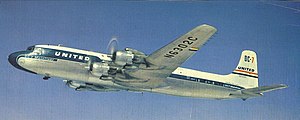1956 Grand Canyon mid-air collision
 An artist's recreation of the collision. | |
| Accident | |
|---|---|
| Date | June 30, 1956 |
| Summary | Midair collision |
| Site | 21,000 feet above the Grand Canyon |
| Total fatalities | 128 (all) |
| Total survivors | 0 |
| First aircraft | |
 A United Airlines DC-7, similar to the one in the accident | |
| Type | Douglas DC-7 Mainliner |
| Name | Mainliner Vancouver |
| Operator | United Airlines |
| Registration | N6324C |
| Flight origin | Los Angeles Int'l Airport |
| Destination | Chicago Midway Airport |
| Passengers | 53 |
| Crew | 5 |
| Fatalities | 58 |
| Survivors | 0 |
| Second aircraft | |
| Type | Lockheed L-1049A Super Constellation |
| Name | Star of the Seine |
| Operator | Trans World Airlines |
| Registration | N6902C |
| Flight origin | Los Angeles Int'l Airport |
| Destination | Kansas City Downtown Airport |
| Passengers | 64 |
| Crew | 6 |
| Fatalities | 70 |
| Survivors | 0 |
The 1956 Grand Canyon was a mid-air collision that happened on Saturday, 30 June 1956 at 11:31 am Mountain Standard Time. A United Airlines plane running as United Airlines Flight 718 hit another airplane owned by Trans World Airlines (TWA), operating as Trans World Airlines Flight 2. The aircraft involved was a Douglas DC-7 and a Lockheed L-1049 Super Constellation. The crash happened over the Grand Canyon within the boundaries of Grand Canyon National Park. All 128 passengers and crew on board both flights died in the collision.[1][2] The crash was the first commercial airline crash with over 100 deaths, and led to lots of changes in flight control in the United States. The crash site today is considered as a National Historic Landmark.[1]
Aircraft
[change | change source]A total of two airplanes were involved in the collision. These planes were:
United Airlines Flight 718 - nicknamed Mainliner Vancouver, the aircraft was a Douglas DC-7. The airplane had an aircraft registration of N6324C. The aircraft carried a total of 58 people (53 passengers and 5 crew members). The aircraft was flying under the orders of pilot Robert F. Shirley, co-pilot Robert W. Harms,and flight engineer Gerard Fiore.[3]
Trans World Airlines Flight 2 - nicknamed Star of the Seine, the aircraft was a Lockheed L-1049 Super Constellation. The aircraft had an aircraft registration of N6902C. The aircraft carried 70 people (64 passengers and 6 crew members). The aircraft was flying under the orders of pilot Jack S. Gandy, co-pilot James H. Ritner, and flight engineer Forrest D. Breyfogle.[3]
Collision
[change | change source]At about 11:31 AM MST, the track of both airplanes intersected over the canyon, and they hit each other.[4]
Gallery
[change | change source]-
A United Airlines DC-7, similar to the one in the accident.
-
An airplane part from TWA Flight 2 that broke off during the collision. The image was taken by park rangers. as part of the collision investigation.
-
The burial site and memorial for the civilians on board TWA Flight 2. The memorial site is located in Flagstaff, Arizona.
References
[change | change source]- ↑ 1.0 1.1 Shedlowski, Kirby-Lynn; Oltrogge, Maureen (17 June 2014). "Grand Canyon National Park to Commemorate Designation of New National Historic Landmark 1956 Grand Canyon TWA-United Airlines Aviation Accident Site". National Park Service. Retrieved 25 December 2016.
- ↑ Berger, Todd (Summer 2006). "The 1956 Airliner Disaster at Grand Canyon" (PDF). The Grand Canyon Association. pp. 1–2. Archived from the original (PDF) on 31 July 2012. Retrieved 25 December 2016.
- ↑ 3.0 3.1 "Midair collision, Accident Investigation Report, Trans World Airlines Lockheed 1049A N6902C and United Air Lines Douglas DC-7 N6324C, over the Grand Canyon, Arizona, June 30, 1956" (PDF). fss.aero. Retrieved 25 December 2016.
- ↑ CAB Docket 320, File 1, Analysis, Paragraph 5, issued 1957/04/17




